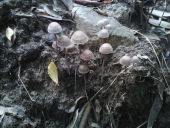




Central Taiwan. Pan-tropical Growing zone 10A?




dan long wrote: Or would I have to formulate compost specifically for the species i'm growing (leaves, grass clippings, weeds etc for one kind and stable bedding for the other).




John Elliott wrote:
dan long wrote: Or would I have to formulate compost specifically for the species i'm growing (leaves, grass clippings, weeds etc for one kind and stable bedding for the other).
Yea, that. The answer to this and your other post about leaching manure are the same: you have to create the environment that the mushroom is accustomed to growing in to get a successful culture.
In the science of mycology, there is a thimbleful of knowledge and an ocean of facts waiting to be discovered. I came across a statistic once (more like a wild-ass guess) that there are about 75,000 known species of fungi, out of an estimated 1 to 2 million, i.e., 95% of the species of fungi are waiting to be discovered. While it is an easy matter to count up the number of species reported in the scientific literature, I still haven't received a satisfactory answer as to how the experts come up with the 1 to 2 million figure. And that's just counting the species out there, never mind the data about their relationships to each other, evolutionary history, metabolic pathways, growth conditions, genetics, etc. There is a lot to be learned and damn few mycologists with fully funded research programs.
So rather than be disappointed that the information is not out there, you should look on it as a challenge. Try new media (composts) and see what happens when you inoculate it. Let manure sit out in the elements and get rained on for one, two, maybe three months before you sterilize it and inoculate it. There are a lot of negative results to be had -- coprophilic mushrooms evolved to grow on poop and there is a lot of dead, decaying stuff that they won't grow on. The science question waiting to be answered is: "what is it about poop that makes it such a good media for them"? Is it the pH? eH? Maybe the ratio of nitrate to ammonia? Then after you start answering that question, you can start using the knowledge: how much poop (and of what type) do you have to mix in with your other media to get the coprophilic ones to grow?
Have you done a search of all the scientific literature on the species that you want to grow? Do you need help chasing that down?
Central Taiwan. Pan-tropical Growing zone 10A?




dan long wrote:
I there any better way to find scientific research besides using google scholar?




John Elliott wrote:
Google scholar does make things easy to find. When I was in graduate school, way back in the last millenium, the Internet was routed through 300 baud modems. Needless to say, nothing was "on line" and we did our research in libraries. Are you close to a major university research library? I don't know that a research library is going to be better, the last time I went prowling through a research library, I was disappointed to find that most of what I was looking for was discontinued, unavailable, or only available through inter-library loan. It seems that the ease of online researching is becoming a death knell for real libraries as the budget cutting administrators see another place to chop dollars.
But with online availability comes a big drawback -- the publishers want big bucks for access to more than just the abstract. A lot more than it used to cost to feed nickels into the Xerox machine at a real library. Sometimes you can luck out and check the author's home page at his institution and he may have made a .pdf reprint available. That's why I like to put filetype:pdf into the search string when I am on Google Scholar. From there you can look through the rest of the author's publications and presentations that may not come up as search hits.
Central Taiwan. Pan-tropical Growing zone 10A?





|
And then we all jump out and yell "surprise! we got you this tiny ad!"
The new kickstarter is now live!
https://www.kickstarter.com/projects/paulwheaton/garden-cards
|



